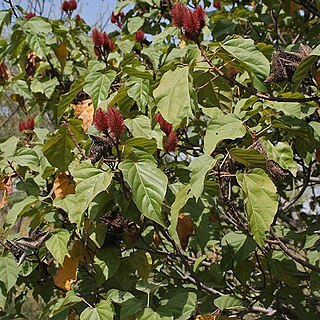Shrubs or small trees, with reddish-orange sap. Leaves alternate, long-petio-late, stipulate, the blade simple, palminerved. Inflorescences terminal, paniculate. Flowers X, actinomorphic; pedicel bearing 5 conspicuous glands below the calyx; sepals 5, distinct, imbricate, fugacious; petals 5, distinct, imbricate, white or pink, fugacious; stamens oc, distinct, inserted on a thick receptacle, the anthers 2-thecate, hippocrepiform, apically dehiscent by 2 narrow slits; pollen 3-colporate, the sexine reticulate or striate-reticulate; gynoecium with 2 syncarpous carpels, the ovary superior, 1-locular, with 2 parietal placentae, the ovules cc, anatropous, the style simple, the stigma shortly 2-lobulate. Fruits capsular, loculicidally 2-valvate, the pericarp densely covered with flexible spines to nearly unarmed; seeds numerous, with fleshy, reddish testa, the endosperm copious, the embryo straight.
Trees or shrubs. Leaves simple, red-dotted; stipules small, caducous. Flowers in terminal panicles or corymbs; pedicels glandular near apex. Sepals 4 or 5, shed at anthesis. Petals 4–7, pink or white. Anthers horseshoe-shaped, opening at apex by slits forming a pore. Ovary setose; style stout; stigma bilobed; ovules many. Fruit a loculicidal, bivalved capsule. Seeds many, angular; testa fleshy; endosperm present.
Morphological characters and geographic distribution are the same as those of the family.
Characters of the family.
Characters of the family.
Characters of the family.

